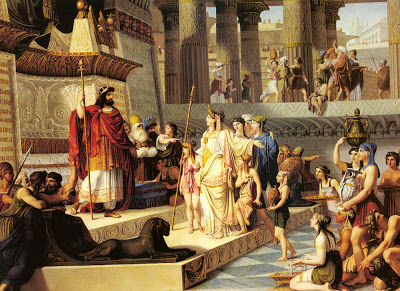[Greek] θρόνος (thronos), [Latin] sedes, [Latin] requietionis: throne, stately seat, power, seat of authority, chair, chair of a sovereignty, seat of government, Mt. 5:34, Mt.23:23, Act.7:49, Lk.1:52, Rev.2:13, Col.1:16 and others

Queen Bathsheba intercedes and speaks to her son King Solomon on the peoples’ behalf. Queen Bathsheba becomes the precursor for Mary interceding on our behalf.
Background Information:
Greek Hellenism: This term means seat, chair, sovereignty, power, and authority. This type of seat is generally associated with kings, deities, and gods. However, from the time of Plato, this term can refer to the teaching chair (position) of the philosopher. The royal throne comes from the orient, where the absolute ruler sits on a magnificent throne. The divine throne generally originates from the influence of Zeus. The Greek tragedy, a very popular literary genre, provided a glimpse into the human condition (tragedy) pertaining to men, kings, and gods.
Old Testament: The throne becomes the source of authority for kings, the queen mother, and judicial governors. The king and the throne are closely interconnected. Thrones, such as the throne of David (and Solomon), can exhibit both earthly authority and divine characteristics. The Old Testament concept of the throne of God takes its imagery from the earthly throne. Heaven is the seat of the divine throne. The heavenly throne is characterized by transcendent majesty, eternity, and righteousness.
Petitioning the King in the Old Testament culture: In the court of petitions, the king is seated in his chair of authority. When the Queens enters the room, the king will get up, bows and pays homage to his mother. The Queen Mother, seated in her chair at the king’s right hand, is bestowed the authority to hear the petitions from the people. The Queen then brings these petitions to her son, the king. Essentially, the Queens acts as an intercessor. The king will not refuse her request. In 1Kgs.2:13-19 Adonijah, son of Haggith, pleaded to Queen Bathsheba that she ask her son King Solomon to accept his request to marry Abishag. Queen Bathsheba responded, “Very well, I will speak to the king for you.”
New Testament: This term can mean throne, ruler, supernatural power, authority to rule, and place of ruling. Jesus’ throne in heaven sits at the right hand of God. The vast majority of examples refer to a heavenly throne (God’s throne). In the Canticle of Mary, Mary speaks of the Lord’s power and majesty which can throw down rulers from their thrones. The thrones (dominions and principalities) refer to the supernatural powers and spirits. Satan’s throne resides in Pergamum, one of the communities in the Book of Revelations. Pergamum was faced with emperor worship and pagan worship. The Pergamos cult of Aesculapius, whose symbol was a serpent, claimed medical healings.
Scripture:
“For in Him were created all things in heaven and on earth, the visible and invisible, whether thrones or dominions or principalities or powers.” Col. 1:16
The principalities and powers are of the domain of the supernatural beings and spirits.
“I know that you live where Satan’s throne is, and yet hold fast to my name and have not denied your faith in me, not even in the days of Antipas, my faithful witness, who was martyred among you, where Satan lives.” Rev.2:13
Pergamum, although having received the faith, was dealing with pagan and emperor worship.
“A high priest, who has taken His seat at the right hand of the throne of the Majesty in heaven.” Heb. 8:1
Jesus sits on his throne in heaven.
Conclusion:
Throne, sediment, sedentary, quiet
I did not realize that the idea of a royal throne comes from the eastern traditions. It does makes sense that the Greek tragedies would often focus on kings and thrones. What better way to shed light on politics, power, and the human condition. It is interesting that a chair can be a position of teaching authority. This becomes a precursor to the office (position) of professors and teachers in the modern university. The bishop’s “chair” is called the kathedra. This is where we get the term cathedral, the seat of the bishop’s authority.
The Old Testament culture begins the development of the throne of God, which is a source of righteousness, majesty, and eternity. The throne sheds light on both the King and Queen Mother. The Old Testament provides scriptural support for the role of the Queen Mother as an intercessor (intermediary). The King will honor the Queen Mother’s request. In addition, this idea makes sense in a practical standpoint. Assuming that the king has many wives, which wife would the king choose to sit beside him? Therefore, the honor goes to the Queen Mother.
This is significant in that it provides support for Mary’s role as an intercessor. For the New Testament, this brings into mind the wedding of Cana. It was brought to Mary’s attention that they had no wine. Mary relays this information to her son Jesus. She instructs them, “Do whatever He tells you.”
Catholic perspective: Many Christians are often uncomfortable with the notion of asking Mary for help. These Christians often say that this elevates Mary too much in her relationship with her son Jesus. However, the Old Testament proves that these actions are appropriate. Mary is also the Queen Mother and Mother of God. What better way to reach Jesus than through His Mother! And Jesus will honor His Mother’s request!
